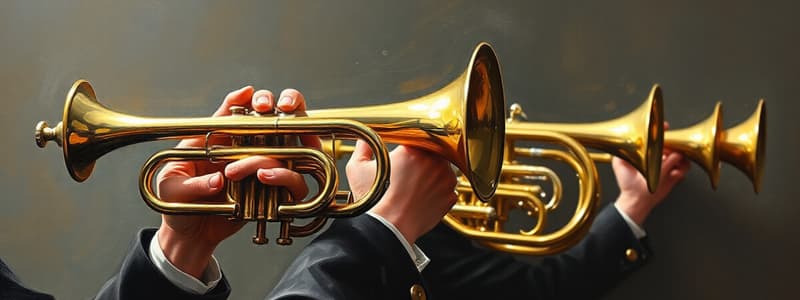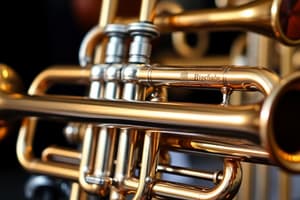Podcast
Questions and Answers
Which characteristic is common to all brass instruments?
Which characteristic is common to all brass instruments?
- Primarily used in marching bands.
- Having a fixed pitch.
- Being constructed with a bell-shaped end. (correct)
- Utilizing a reed for sound production.
What is the primary method of altering pitch on brass instruments?
What is the primary method of altering pitch on brass instruments?
- Pressing keys to open and close holes.
- Adjusting the length of the instrument.
- Changing the force of the air blown into the instrument.
- Using a combination of lip control and valves. (correct)
How does the length of the air column relate to the pitch produced by a brass instrument?
How does the length of the air column relate to the pitch produced by a brass instrument?
- A shorter air column produces a lower pitch.
- A longer air column produces a lower pitch. (correct)
- The length of the air column does not affect the pitch.
- A longer air column produces a higher pitch.
Which of the following instruments is NOT typically found in a standard orchestra setting?
Which of the following instruments is NOT typically found in a standard orchestra setting?
Which brass instrument is known for typically playing the highest notes in the brass section?
Which brass instrument is known for typically playing the highest notes in the brass section?
What does it mean for a brass instrument to be a 'transposing' instrument?
What does it mean for a brass instrument to be a 'transposing' instrument?
Which clef is NOT commonly used for the trombone?
Which clef is NOT commonly used for the trombone?
Which of the following is a key characteristic of the French horn's sound?
Which of the following is a key characteristic of the French horn's sound?
Which term describes the capability of some instruments to produce a continuous slide in pitch?
Which term describes the capability of some instruments to produce a continuous slide in pitch?
Why is it important to lubricate the valves of a brass instrument?
Why is it important to lubricate the valves of a brass instrument?
Flashcards
Brass Instrument Sound
Brass Instrument Sound
Sound produced by vibrating air columns within the instrument.
Trumpet Characteristics
Trumpet Characteristics
Trumpet is the highest-pitched instrument in the brass family, known for its bright, powerful, and majestic tone achieved using 3 valves.
Transposing Instrument
Transposing Instrument
A musical instrument that transposes notes, meaning the written pitch differs from the actual sound produced.
Trombone
Trombone
Signup and view all the flashcards
Tuba
Tuba
Signup and view all the flashcards
Cornet
Cornet
Signup and view all the flashcards
Brass Instrument Maintenance
Brass Instrument Maintenance
Signup and view all the flashcards
Valve and Slide Maintenance
Valve and Slide Maintenance
Signup and view all the flashcards
Study Notes
- The brass wind section instruments are made of brass tubes with a mouthpiece and a bell-shaped end.
- The sound is produced by vibrating the air columns.
- Pitch changes because of the lips and valves.
- Longer air columns produce slower sounds and a bigger instrument produces slower sounds.
Main brass wind instruments
- Trumpet
- Tuba
- Trombone
- French horn
- Cornet
Trumpet
- Delivers the highest notes in the brass section
- Has a bright, powerful, and majestic tone
- Uses three valves to produce notes
- It is a transposing instrument
- Uses treble clef
- Can obtain a complete chromatic scale
- Trumpets tuned to B flat sound a major 2nd lower than written notes.
- Range = f
French horn
- Is commonly a transposing brass instrument
- Uses three valves to produce notes
- Mellow and majestic tone
- French horns blend well with other instruments
- Uses treble and bass clefs
- Has a range of over 3 1/2 octaves
- Range = f
Trombone/Stackbut
- Transposing brass wind instrument
- Uses a slide to produce notes
- There are 2 tenor and 1 bass trombones in the orchestra, only 3 trombones
- Uses bass and tenor clefs
- Three types of trombones are Alto, Tenor, and Bass
- Range =
Tuba
- Non-transposing brass wind instrument
- Uses three valves to produce notes
- Plays lowest notes in the orchestra
- Uses bass clef
- Tenor Tuba in B flat is called Euphonium
- Range = 8vb
Cornet
- Transposing brass wind instrument
- Uses three valves to produce notes
- Not powerful as trumpet
- Sounds a Major 2nd lower than written notes.
Maintaining Brass Wind Instruments
- Valves must be lubricated with oil and slide grease
- Following use, clean the instrument by opening the spit valve
- Wipe the instrument using appropriate cloth
- Clean the instrument once a month with soap and lukewarm water and thoroughly towel dry to prevent corrosion.
Instruments
- Instruments that play Gilisando include the Double Bass and Harp
- Instruments that can use a mute include violins, violas, cellos, trombones, pianofortes, timpani, C trumpets, French horns, and tubas
- Double bass and woodwind instruments are never muted.
Studying That Suits You
Use AI to generate personalized quizzes and flashcards to suit your learning preferences.





